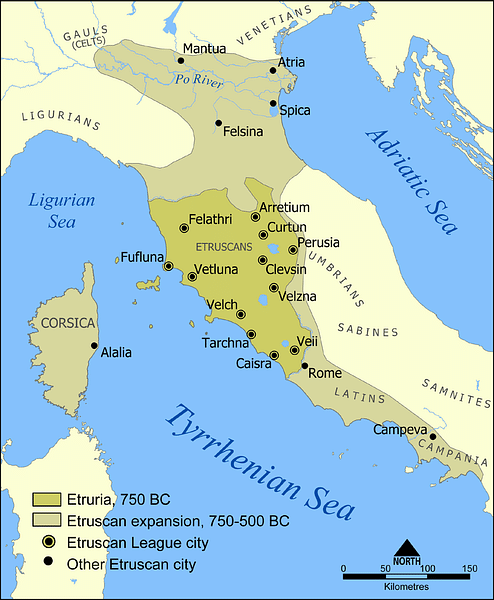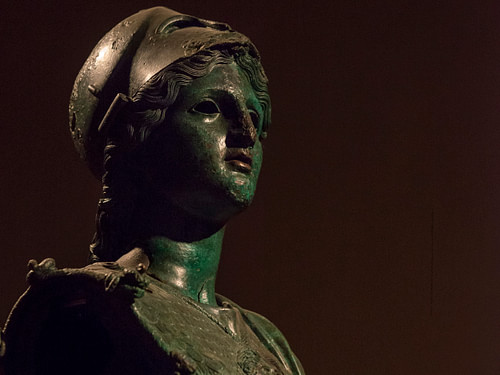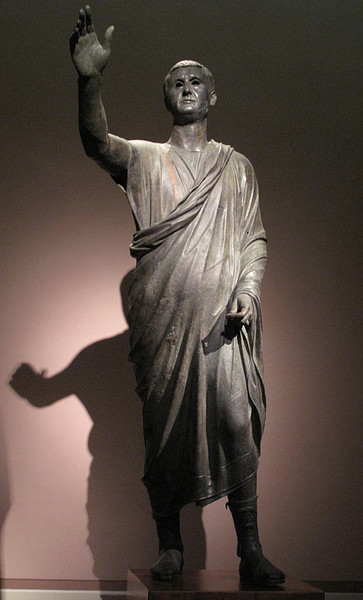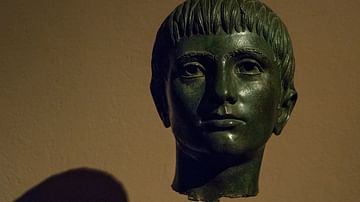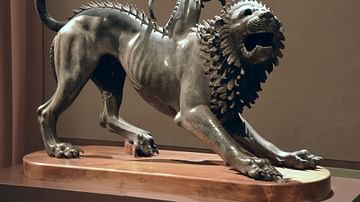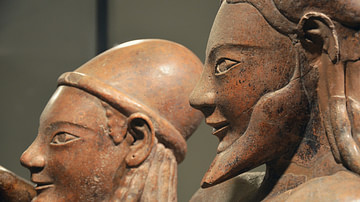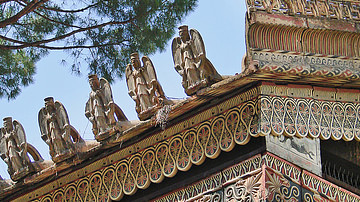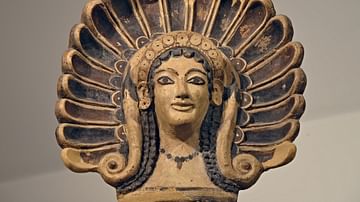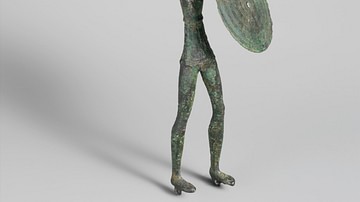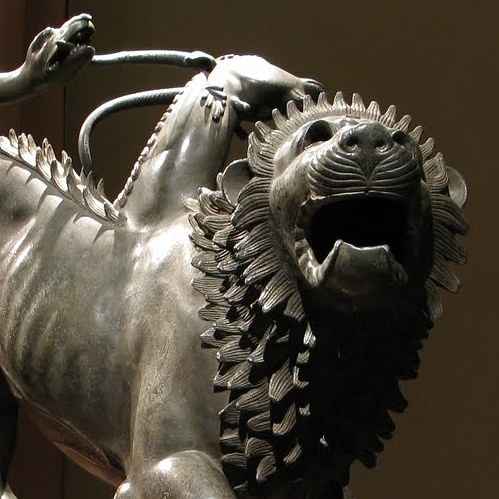
Arretium (modern Arezzo) was an important Etruscan town located in the extreme north-east of Etruria in central Italy. Flourishing as a trade and manufacturing centre, Arretium managed to overcome its rivalry with Rome and continue as a prosperous town into the Imperial period. Although much of its ancient architecture has disappeared, one significant legacy from the Etruscan period is the magnificent bronze statue known as the Chimera of Arezzo, perhaps that culture's finest surviving art piece.
Early Settlement
Although human habitation of the site dates back to the Palaeolithic Period, Arretium was something of a late starter compared to other Etruscan sites which sprang up in the Villanovan Period (1100-750 BCE). Etruscan Arretium was established, rather, sometime in the 6th century BCE. Arretium prospered due to its geographical location at the junction of the Tiber River and Arno River valleys. The settlement was also situated near a break in the Apennine Mountains giving access for wider Etruria to the Adriatic coastal region of eastern Italy.
Etruscan Arretium
Prospering as a trading hub, the town also manufactured its own goods, particularly bronze works, pottery, and terracotta statues. The artists of Arretium produced perhaps the finest single surviving Etruscan artwork, the 'Chimera of Arezzo.' This 5th-4th-century BCE representation of the mythical part-lion part-goat part-snake creature, exquisitely cast in bronze, was miraculously found in a ditch in 1553 CE when new fortifications were being raised by Cosimo de' Medici, the Grand Duke of Tuscany. It now takes pride of place in the National Archaeological Museum of Florence.
Relations with Rome
Arretium had a troubled relationship with her powerful neighbour Rome. According to Dionysius of Halicarnassus, the town sided with the Latins during the 6th century BCE in their battles with the Roman king Tarquinius Priscus. Illustrating the ambiguous nature of Etruscan-Roman relations over the centuries, the Roman historian Livy states that Rome actually helped Arretium in 302 BCE, or at least its ruling aristocracy. The dominant Cilnii clan faced a popular uprising from an increasingly disillusioned lower class and called in Rome for help. A Roman force was sent but was attacked and badly mauled in an ambush. A second larger force, led by the dictator Marcus Valerius Maximus, swiftly restored order. Rome was beginning to show an alarming interest in Etruscan affairs.
Rusellae (modern Roselle) was sacked in 294 BCE, a stark warning of the futility of opposing Rome. According to Livy, the Etruscan towns of Volsinii, Perusia, and Arretium then negotiated a peace with Rome. The price for a 40-year truce was a huge 500,000 asses per city. The truce did not last very long as, in 284 BCE, Volsinii took advantage of an invading army of Gauls to join them and attack Arretium, then loyal to Rome. A relieving Roman army was defeated, but the next year the Romans, led by P. Cornelius Dolabella, won a decisive victory at the Battle of Lake Vadimo.
During the latter half of the 3rd century BCE, Arretium was also attacked by Carthage. However, the city was an ally (albeit a passive one) of Hannibal during his attacks in Italy during the Second Punic War (218-201 BCE), despite previously promising loyalty to Rome and often acting as an important Roman base from which to launch attacks in northern Italy. In the complex and delicate situation of a foreign army in Italy and Etruscan cities of dubious allegiance, Rome attempted to ensure greater loyalty by taking a number of hostages from Arretium's ruling families. When the Romans won victory over Carthage, Arretium's lack of support was not forgotten and the city was made to pay compensation by way of thousands of pieces of bronze weapons and armour.
Arretium then seems to have settled down as a minor town within the burgeoning Roman empire. In the 2nd century BCE, part of its territory was redistributed to Roman veterans, but it did benefit from being the first stopping point on the via Cassia which went from Rome and crossed the Apennines to Aquileia. In the early 1st century BCE Arretium was made a municipium. The city then made the fateful decision to back the wrong side in Rome's civil war, supporting Gaius Marius. The victor, Sulla, made a colony and resettled his veterans at Arretium in 80 BCE; Julius Caesar was to do exactly the same before the century was out.
Having got over its initial problems with Rome's expansion, Arretium became a relatively prosperous Roman town in the early Imperial period, no doubt helped by the fact that Emperor Augustus' great confidant, Gaius Maecenas, was a native of Arretium. Benefits included construction of an amphitheatre, theatre, forum, and Roman baths. The town also became noted as a major production centre for the Arretina terra sigillata pottery with its distinctive coral colour and which was exported widely throughout the Roman world. The town gradually slipped into obscurity from the 2nd century CE when Trajan made the decision to connect the via Cassia directly to Florentia (Florence), thus bypassing Arretium and robbing it of its commercial traffic. The town would regain some of its former glory in the late Middle Ages, though, when it became an independent city-state once again.
Archaeological Remains
As with other Etruscan towns that have since been built over in medieval times and which continued to be occupied today, the archaeology of ancient Arretium has met with difficulties. There are traces of fortification walls from the period. Two Etruscan sanctuaries on the outskirts of Arretium are indicated by the presence of votive offerings. One, the Fonte Veneziana (named after a fountain near one of the city gates), had some 200 items in a votive pit. They included bronze figurines of humans and animals (some with gold leaf decoration), pottery vessels, and anatomical plaques of eyes, arms, legs, and busts. The second deposit at Monti Falterona was a lake in use between the 6th and 3rd century BCE where offerings were thrown in such as arrow heads, nuggets of bronze, pottery fragments, and bronze figurines. Fine examples of the latter category are a bronze male head and a warrior statuette, both are now in the British Museum, London.
From the Roman period, there are remains of pottery workshops and some private housing. In addition, there is a lower course and several arches of the Roman amphitheatre still in situ, which gives an idea of the outline of the building.
Besides the magnificent Chimera already mentioned, other fine bronze statues are the 'Minerva of Arezzo' (3rd-1st century BCE), a 4th-century BCE statuette of two oxen and a ploughman, and a 1st-century BCE lifesize figure known as the Arringatore or 'Orator.' The latter work was discovered near Lake Trasimene in 1566 CE. The confident figure with arm raised in appeal and wearing a toga is perhaps the answer to the frequently asked question 'what became of the Etruscans?': they became Romans.
